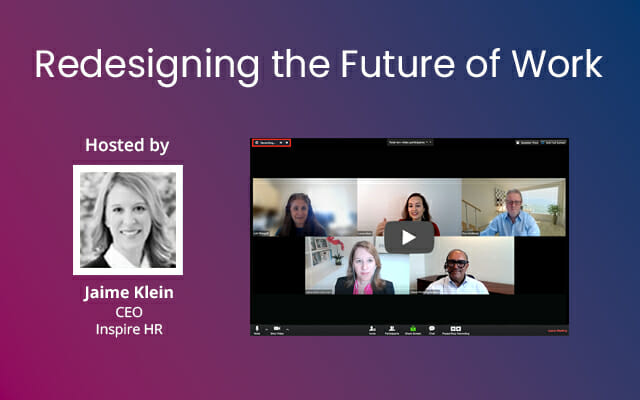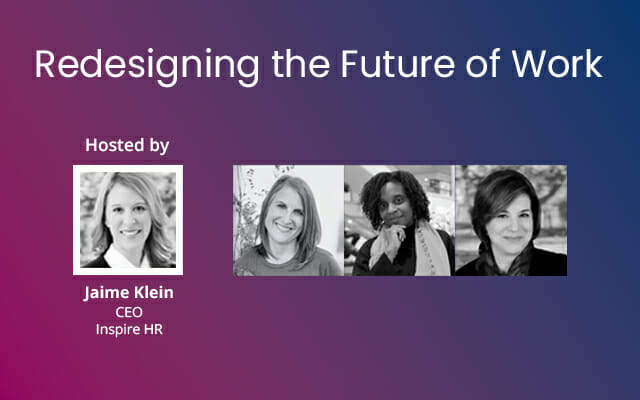
4 Myths of AI’s Impact on the Workforce
NOV 30, 2019
To many, artificial intelligence (AI) presents an almost endless sea of opportunity. But if AI scares you, you’re not alone.
As consumers, as employers, and simply as people, the concept of replacing humans with robots in any capacity can feel uncomfortable. Steven Spielberg signed all of us up for some deep soul-searching in 2001’s AI. The film questions just what distinguishes humans from machines and if we can ever bridge that gap.
This kind of questioning is everywhere in business today, too. Which functions require a human, which could be accomplished by AI? What does AI mean for the workforce of the future? What does it mean for the workforce of today? It can be confusing and frustrating to try to predict just how AI is going to manifest in our industries and companies.
Even though we can’t see into the future, we can be strategic in how we plan for it. Modern human resources leaders who excel at people management are always looking to what’s next. It’s how we help position our companies to be long-lasting powerhouses.
And it’s exactly what our companies and bosses need from us. When I ask a CEO, “What keeps you up at night?” nine times out of ten, it’s the challenge of how to keep up with the rapid pace of innovation in the workplace.
So, let’s remove some of the uncertainty that surrounds AI and can sometimes hinder our ability to be proactive. Let’s see AI as a tool for us, not against us. Let’s prepare for the future of work!
4 Myths of AI’s Impact on the Workforce
Myth #1: Robots are taking our jobs!
The business advances made possible through AI aren’t necessarily going to have a negative effect on workers at all. The jury is still out, and, in fact, there is growing evidence pointing toward a neutral or even positive impact that AI will have on unemployment rates.
History shows us that technological advancements do not lead to greater unemployment. Look at the introduction of Automated Teller Machines (ATMs) in the 1970s. Johan C. Aurik, Global Managing Partner Emeritus at A.T.Kearney remembers how the conversation around these new machines was dominated by the fear that bank tellers would lose their jobs en masse. In reality, though, bank employees were freed up to focus more on customer relationships while banks were able to open more branches and hire more people.
In 2017, Panera announced they would hire 10,000 workers and credited the success of their automated online and kiosk ordering systems for the ability to staff up. Automation in the ordering process resulted in hiring needs for drivers and customer service in the catering and delivery department.
And, let’s not forget that machines are not autonomous beings. It is humans—you, me, our teams—that identify the problems and priorities where AI will focus. We can all remember the seemingly endless sifting through resumes and cover letters that led to the development of a much more efficient process. Can you even imagine working without an applicant tracking system (ATS) today?
These programs didn’t pop up out of nowhere. We identified a problem, then found a solution. “After all, humans do not simply endure technological disruption,” explains Abdul Razack, Head of Platforms at Infosys. “They help shape it as part of our future. The advent of the automobile didn’t just help us travel faster and further; rather, it led to roads, highways, and entirely new industries.”
Where PWC predicts a small wave of displacement (3%) in the next couple of years, they caution that up to 30% of workers could be displaced by the mid-2030s. On the flip side, strategic planning firm Gartner predicts that, by the end of this year, AI will have created more jobs than it has eliminated—about 500,000 more. The best part—this growth will involve more strategic and interactive jobs.
As Razack says, “It’s not a question of man versus machine, but man and machine.”
These jobs will require a higher digital IQ among the workers displaced from their original functions. People must be able to work alongside machines and bring value in a new way. It isn’t easy, but this upskilling is one of the most crucial tasks facing human resources leaders today. Modern HR departments simply cannot ignore it.
Myth #2: AI primarily affects tactical (blue-collar) jobs
AI affects all of us—not just a particular subset of the workforce.
If you’re a C-suite leader, holding a primarily strategic role, you may feel (and may have been told) you are immune to AI disruption.
Not so.
Ginni Rommety, chair, president, and CEO of IBM notes today we are in the midst of the most rapid period of technological advancement we have ever seen. And the development of the tech giant’s most famous robot, Watson, “starts with a fundamental belief that it’s going to change 100% of jobs, 100% of industries, and 100% of professions,” Rommety says.
This means us, HR leaders. It also means the C-suite at our firms, middle-managers, entry-levels…you name it. Whether it’s evaluating a direct report’s performance, prioritizing departmental goals, analyzing budgets, and basically every other aspect of a manager or even an executive’s job, AI will assist us.
Not sure if that email from your colleague meant she was upset that she wasn’t invited to the meeting, or she simply needed an answer to an innocent question? AI is even helping to analyze the tone of emails you receive.
In PWC’s “Artificial Intelligence in HR: a No-Brainer,” human resources leaders from multiple industries share the importance of machine learning to help strategists develop more insightful priorities, in addition to giving recruiters more face time, introducing consistency to orientation and training procedures, and minimizing human bias in hiring and managing.
No one has “made it” to the extent that AI doesn’t affect their job performance. None of us can rest on our laurels or fall back on the excuse, “I’m not very tech-y.”
On the contrary, AI offers the opportunity for continuous improvement—and the data to measure it. We all need to do our part to keep up.
Myth #3: AI is something coming in the future
AI isn’t coming. AI is here.
If you envision AI as robots that resemble humans standing on assembly lines, sitting behind desks, driving cars, or assessing your blood pressure, then the whole concept may seem quite futuristic.
Consider instead the pop-up on a website that asks if you’d like to chat. Or, the ordering kiosks at Panera and McDonald’s. Cars that park themselves. IPads where you update your medical information while sitting in the waiting room for your annual physical…
AI is here. Today. Rosie from the Jetsons actually materialized as Alexa with a Roomba.
Even if your organization does not utilize much machine-learning today, it’s only a matter of time before it must. It’s urgently becoming a non-negotiable for successful businesses. And, data collected today will inform the automated functions of the future.
Data scientists and analysts are among the most sought-after positions in the country and for good reason. Now is the time to work together to uncover those repetitive tasks, efficiency barriers, and opportunities for competitive advantage. These can be your partners who add quantitative insight and data to enrich your deep experience in people management.
Earlier this year I attended the New York Times “New Rules Summit,” and I must have heard a dozen times about the importance of tracking behaviors, outcomes, and processes starting yesterday.
AI isn’t meant to be a hammer looking for nails—it isn’t an end in itself. Instead, it is on us as people (especially human resources leaders) to determine our current states, goals, barriers, and performance measurements.
If you sit down with an IT vendor one year from today to discuss an automation opportunity, you’ll want today’s data on the table. Waiting until that meeting to assess where you are is too late.
Myth #4: AI is for the tech team
The implementation of AI throughout the workplace is largely a function of human resources—not just IT.
Sure, our CTO friends will be the ones helping to implement the technology that integrates AI throughout our organization. They play a crucial role, and frankly, if you don’t have a strong technology leader in your company, this should be way up there on your priorities list.
But, as I mentioned earlier, AI is not an independent “thing.” It’s more than technology—it’s the technological answer to our very human challenges and opportunities. And who knows those challenges and opportunities better than you, the HR leader? Our business is people, after all. We are the change management experts, and it’s time to fully embrace this role to help our companies embrace the full potential of AI.
Deloitte’s 2018 “Global Human Capital Trends” report unveils a distressing gap: 72% of respondents to the global executive survey see the implementation of AI as important, while just 31% feel ready to address it.
We have to be proactive. As Jeff Wong, EY Global Chief Innovation Officers says, “CEOs and business leaders have a responsibility to not only motivate and inspire their organizations with a strategic vision for the future but to establish a plan that implements AI and other emerging technologies across the workforce.”
What does this mean for human resources leaders?
- Upskilling our workforce, so current truck drivers are able to direct the machines that may be powering the vehicles someday soon.
- Helping the more senior members of your workforce understand why knocking on a door to ask a process question may not be feasible in the future, but interacting with a chatbot offers them much clearer direction and greater opportunity.
- Looking beyond the open positions we are confronted with today and seeing them as opportunities to restructure certain processes, automate current tasks, and augment the digital capacity of the team.
- Stepping up to the plate as business leaders. AI is truly an opportunity for HR leaders to shine. If we wait for our bosses to come to us with the news that a new automated program will result in the loss of 50 jobs, we’re stuck. We’re relegated to a reactionary role. We’re limited by a timeline that we had no influence on creating.
Take a page from the playbook of our tech friends and start innovating today. We can’t wait for a tried-and-true best practice to guide us.
In the AI game, it’s your chance to establish the best practices. Look at your processes, plans, and data as it stands today and map out a pilot that could deliver deeper insight to you and your team.
We don’t know exactly what tomorrow will bring, but we know it will bring change. YOU can be the hero in preparing your team to thrive!







